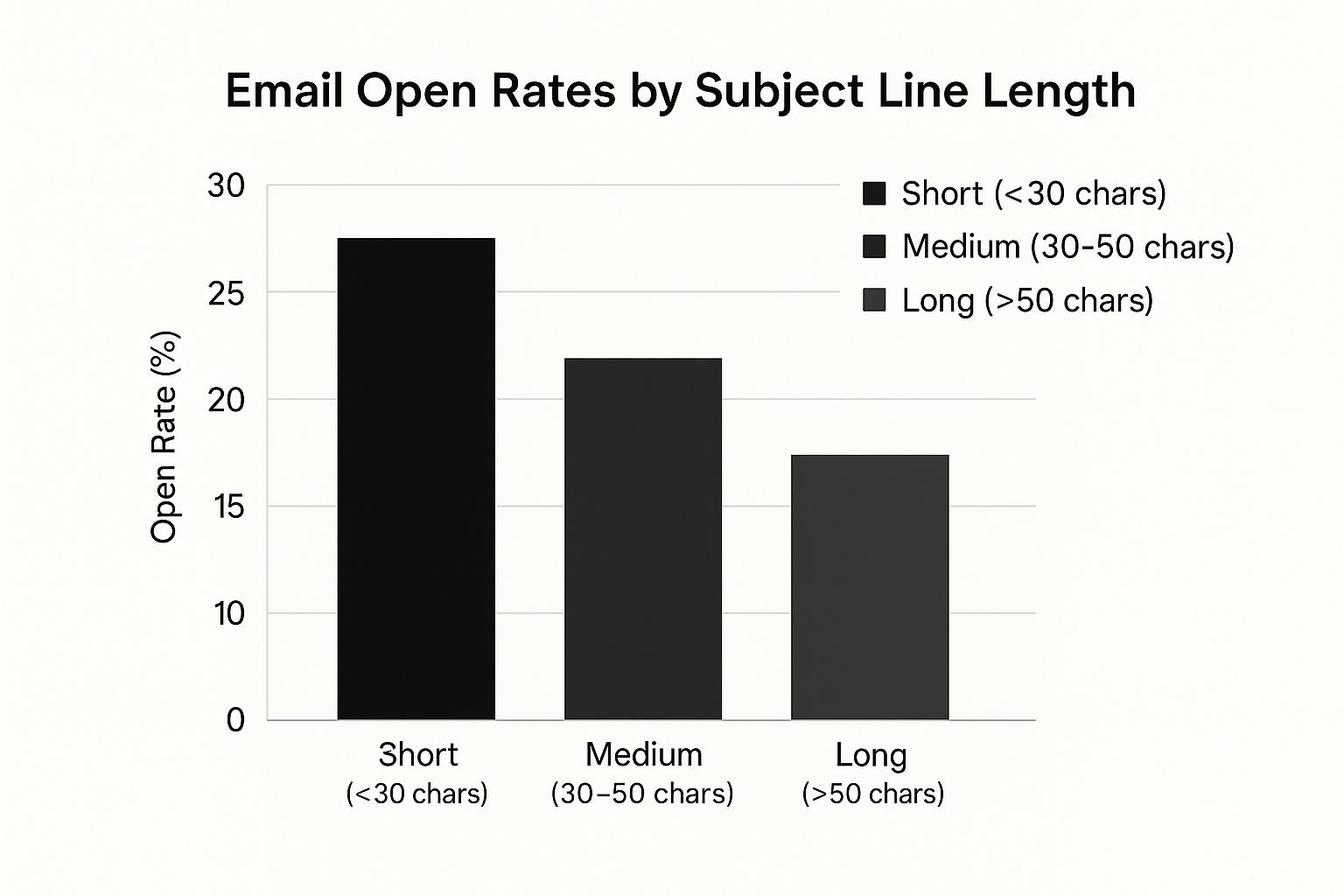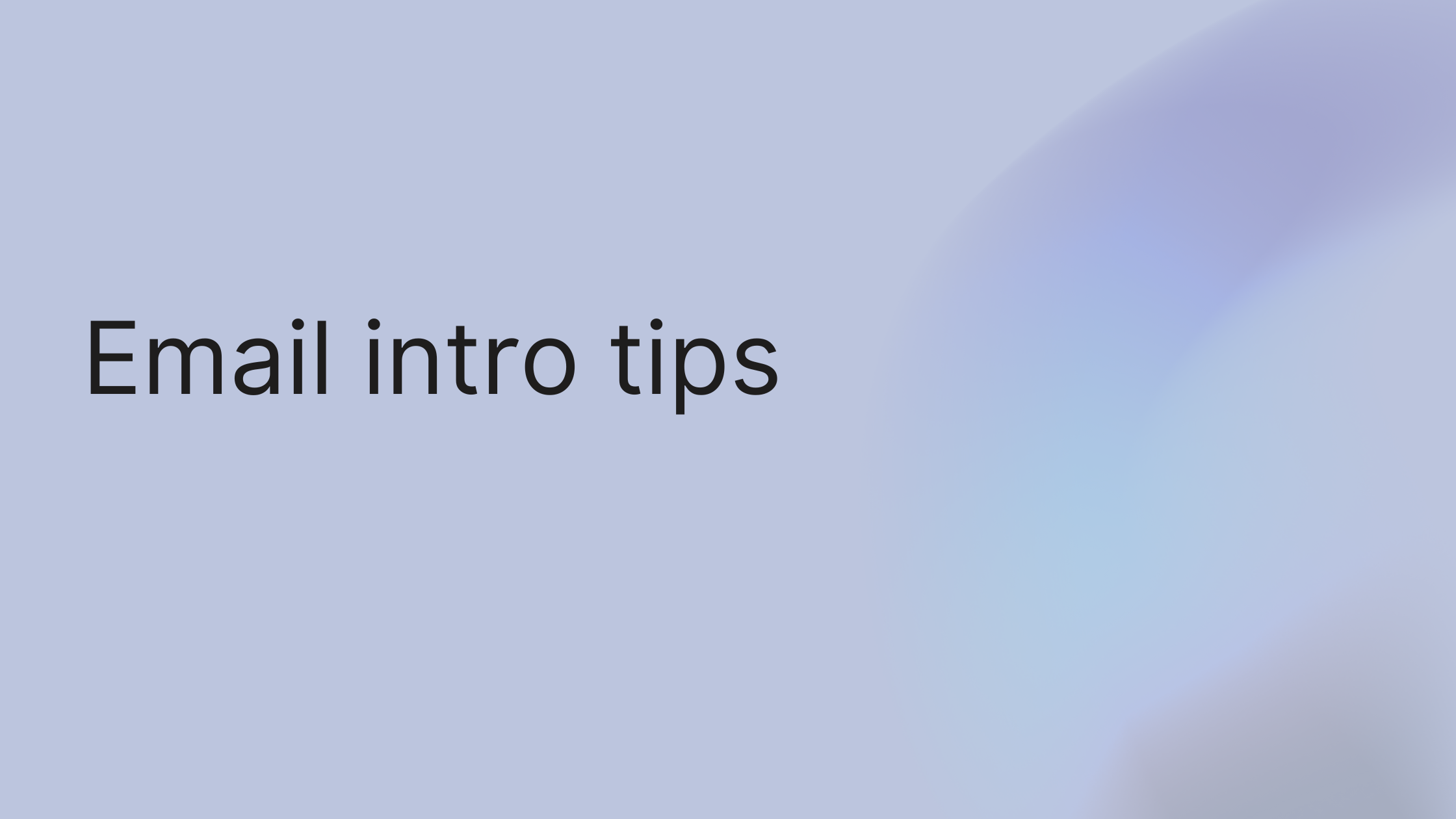Staring at that blinking cursor, trying to find the perfect opening line for an email? We’ve all been there. You know that first sentence will decide if your message gets a thoughtful reply or is instantly deleted. It’s a ton of pressure.
Most people get it wrong. They start with "My name is..." or "I'm with [Company Name]..." and just like that, the recipient's internal sales pitch alarm goes off. It feels generic, and frankly, a little lazy.
The fix is surprisingly simple: Make the first sentence about them, not you. This one small change flips your email from being just another interruption into the start of a relevant conversation.
Step 1: Craft an Opener That Puts Them First
Let's be real, you're not just competing with other salespeople; you're competing with a flood of notifications, newsletters, and internal memos. With nearly 4.5 billion email users worldwide, your recipient's inbox is a battlefield for attention. A generic opener just doesn't stand a chance. If you're curious, you can dig into more of these email trends and why they matter for your outreach.
The goal is to show you've done your homework and aren't just blasting out a template to a list.
The Shift from "Me" to "You"
An effective introduction has one job: to prove your email is worth reading in under five seconds. Instead of a bland self-introduction, try leading with a hook that puts the spotlight on them.
Here are a few actionable ways to do that:
- Reference their work: "I was really impressed with the case study you published on LinkedIn about your Q3 results."
- Mention a mutual connection: "Our mutual connection, Jane Doe, suggested I reach out..."
- Highlight a recent achievement: "Congratulations on your recent promotion to Director of Marketing!"
Real-World Use Case: The 5x Reply Rate Boost
A B2B consulting firm was stuck with a dismal 2% reply rate on their cold emails. Their intro was always, "My name is John and I help companies like yours..." We switched it up.
Actionable Step: They started referencing specific company news, like a recent press release or funding announcement. Their new opener became: "I saw your recent press release about expanding into the APAC market and wanted to reach out."
The Result: Their reply rate shot up to 11% in the first month. This simple, step-by-step change proved they had a genuine reason for reaching out beyond their own agenda.
Step 2: Write a Subject Line That Demands a Click
Have you ever spent a solid 30 minutes crafting the perfect email introduction, only to watch it languish, unopened, in someone's inbox? It's a common frustration, and the culprit is almost always the subject line. Before anyone can appreciate your brilliant opening, they have to get past the gatekeeper.
The good news is that improving your open rates often comes down to one simple change: stop being vague and start getting personal and specific.
Your subject line isn't just a label; it's your first (and sometimes only) shot to prove your email is worth their time. Think about this: a staggering 47% of people decide whether to open an email based on the subject line alone. And when you add a touch of personalization? You can see open rates jump by another 26%. The power of that single line is hard to overstate.
Spark Curiosity Without Being Clickbait
The goal here is to create intrigue, not suspicion. A great subject line hints at the value packed inside without giving it all away or, worse, sounding like a generic marketing blast. The real magic happens when you balance a personal touch with a clear benefit for the reader.
For example, which of these would you rather open?
- Before: "Quick Question"
- After: "Idea for your new [Project Name] project"
The second one works because it's specific, relevant, and ties directly into something the recipient is actively working on. That simple tweak shifts you from being just another interruption in their day to a potentially valuable contributor.
Subject Line Performance Comparison
To see just how much of a difference this makes, let’s compare some common subject lines. It's easy to fall back on generic phrases, but the data consistently shows that specificity and personalization win.
| Subject Line Type | Example | Potential Impact |
|---|---|---|
| Generic | "Following Up" | Low open rates; often ignored or deleted. |
| Personalized | "John, loved your post on LinkedIn" | Higher open rates; shows you've done your research. |
| Vague & Self-Serving | "Our New Product Features" | Very low engagement; feels like a marketing blast. |
| Specific & Value-Driven | "A thought on improving your team's workflow" | High engagement; promises a direct benefit. |
As you can see, the subject lines that connect to the recipient's world or offer clear value are the ones that get the click.
The Impact of Length on Opens
While what you say matters, how much you say in the subject line is also a huge factor. This is especially true in a world where half of all emails are opened on a phone.

The data is pretty clear: shorter, punchier subject lines grab attention and perform better. They're quick to read and less likely to get cut off on mobile screens. Perfecting your subject line is the first step in outreach, just like optimizing a lead capture form is the key to converting visitors on your website.
Step 3: Structure Your Introduction for Readability

So, you wrote a killer subject line and they clicked. Great. Now the clock is ticking. You have about five seconds to convince them the rest of your email is worth their time.
If they open your email and see a dense, clunky paragraph, they're hitting the archive button. It doesn't matter how amazing your offer is. The quickest way to keep their attention is with a clean, scannable structure. It’s not just about the words you choose; it’s about making those words incredibly easy to digest, especially on a phone.
The Hook-Context-Bridge Framework
A strong introduction follows a simple, three-part system. This step-by-step framework helps you hit all the essential notes in just a few short sentences.
- The Hook: This is your why. Kick things off with a personalized line that proves this email isn't just another generic blast. Maybe you mention their latest LinkedIn post, a mutual connection, or a recent company achievement.
- The Context: Now, briefly explain who you are and why you're relevant to them. This isn't your life story. A quick, concise connector like, "I help B2B tech companies like yours solve [specific problem]" is all you need.
- The Bridge: Finally, connect your reason for writing directly to their world. This sentence should clearly state what you want and, more importantly, what’s in it for them. It sets the stage for the rest of your email.
Here’s what that looks like in the growlio.io compose window:

This structure is direct, respects their time, and immediately establishes you as a peer with a relevant idea. To learn more practical advice like this, check out our complete guide on how to write an introduction email.
Step 4: Add Personalization That Genuinely Connects
We’ve all felt that sinking feeling after hitting "send" on a barely customized email, half-knowing it’s going straight to the trash. The good news? Real personalization isn't about some complicated algorithm. It's about being human and showing you've done your homework.
Moving beyond a simple {{first_name}} merge tag is how you start building actual rapport. It’s the difference between an email that gets archived instantly and one that sparks a real conversation. This is especially true in the US, where tailoring your content is a huge factor in building customer loyalty. If you want to dive deeper, you can explore insights on global email marketing trends.
Mini-Case Study: From 4% to 19% Reply Rate
A B2B software company was getting almost no replies from their outreach to marketing VPs. Their introductions were polite, but painfully generic.
Actionable Step: They narrowed their focus to prospects who had recently been on a podcast or published a LinkedIn article. Their new intro template looked like this:
"Hi [Name], I just listened to your interview on the [Podcast Name] and your point about [specific topic] really stood out. I thought you'd be interested in how we're helping teams like yours tackle that exact challenge."
The Result: Their positive reply rate shot up from a dismal 4% to an impressive 19% in a single month. That one small change proved their outreach was thoughtful, not just another automated blast.
Finding Your Personalization Triggers
So, where do you find these golden nuggets of info? It doesn't have to take hours. Here’s a quick checklist of places to find powerful personalization triggers:
- LinkedIn Activity: Check out their recent posts, articles they’ve shared, or even insightful comments they've left on someone else's content.
- Company News: Hit their company website. Are there new press releases, funding announcements, or recent product launches?
- Podcast/Webinar Appearances: A quick Google search for their name plus "podcast" or "webinar" can unearth fantastic material.
- Personal Achievements: Did they just get a promotion or win an award? Mentioning it shows you’re actually paying attention to their career.
Platforms like growlio.io make it easier to manage this research by keeping all your lead and client information in one organized spot.
Pro Tip: The Advanced "Pattern Interrupt"
Want to really stand out with a high-value contact? Go a level deeper than their LinkedIn profile. Find something they said on a podcast, in an article, or during a webinar.
Imagine opening with something like this: "Your comment on the Marketing Over Coffee podcast about 'leading with empathy' really resonated with me..."
That kind of opener creates a powerful, authentic connection that’s almost impossible to ignore. It shows you’re not just a fan of their title, but you’ve actually listened to what they have to say.
Step 5: Use Proven Templates and Examples
It’s one thing to talk about the theory behind a great email intro, but seeing it in action is where things really click. Sometimes, the hardest part is just starting with a blank page.
Let's walk through a template you can actually use. We'll break down a common scenario—cold outreach to a potential client—and I'll explain the thinking behind each line. This way, you can see the 'why' and adapt it for your own needs.
Cold Outreach Template Breakdown
Here’s a practical example of an email introduction that gets replies.
Subject: An idea for [Prospect's Project/Goal]
Line 1 (The Hook): “Hi [Name], I saw your recent LinkedIn post about scaling content production, and your point about maintaining quality really stood out.”
- Why this works: This is personalization done right. It's specific and immediately shows you’ve done your homework. More importantly, it proves you're reaching out for a genuine reason that's about them, not you.
Line 2 (The Context): “As someone who helps B2B SaaS companies create high-quality blog content without the heavy lifting, I thought you might find this interesting.”
- Why this works: This is your quick "who I am and why you should care." It’s concise and directly bridges the gap between your expertise and their stated goal. No fluff, just relevance.
Line 3 (The Bridge & CTA): “I have a specific idea that could help your team publish 2x more content while improving SEO. Are you open to a 15-minute chat next week to walk through it?”
- Why this works: It dangles a clear, tangible benefit (2x more content) and finishes with a low-friction call-to-action. You're not asking for a huge commitment, just a simple conversation that’s easy to say "yes" to.
Getting these first few lines right is a huge step. To learn more about turning that initial reply into a solid relationship, check out our guide on client communication best practices.
Ready to Scale Your Outreach?

It’s a classic growing pain: you’ve nailed personalized outreach, but now you’re drowning in the manual work it takes to scale. Crafting that perfect, tailored introduction for every single prospect is one thing. Turning it into a consistent, predictable way to grow your business is a whole different beast.
When you're trying to grow, your own manual process can quickly become your biggest bottleneck.
The good news is that all the strategies we've covered—from deep personalization to hitting send at just the right moment—don't have to eat up your entire day. You can streamline the whole thing without losing that human touch that actually gets replies. To really make sure your messages land and convert, it’s worth diving deeper into mastering cold email outreach.
Ready to stop doing everything by hand and build a real, scalable outreach system? Start your free growlio account today and begin sending emails that don't just get opened—they start conversations.
Common Questions About Email Introductions
Even with the best templates in hand, you're going to hit some tricky spots. Knowing the basics of writing an email introduction is one thing, but mastering the "what ifs" is what really separates average outreach from consistently successful campaigns.
Let’s tackle a few of the questions I hear all the time.
How Long Should an Email Introduction Be?
Keep it incredibly brief. I'm talking two to four sentences, tops. If you can keep it under 60 words, you're in the sweet spot. Remember, most people are skimming emails on their phones between meetings.
A concise, scannable intro will always beat a dense paragraph. Show them you respect their time, and you're far more likely to get a moment of theirs in return.
What Is the Biggest Mistake to Avoid?
Without a doubt, the single biggest mistake is making the introduction all about you. Kicking things off with "My name is..." or "I work for..." is the fastest way to the trash folder. It screams "sales pitch" from a mile away.
The fix is simple: make the opening about them. Reference their work, a recent company achievement, or a shared connection. This simple flip builds immediate rapport because it proves you’ve actually done your homework. For consultants, this kind of personalized touch is non-negotiable, and it's even more powerful when baked into your workflow, as we cover in our guide to the best CRM for consulting firms.
How Do I Write an Intro Without a Mutual Connection?
When you don't have a shared contact to lean on, your personalization has to work even harder. Your hook needs to be something specific, genuine, and recent. Think about a recent article they wrote, a insightful comment they left on a LinkedIn post, or a project their company just launched.
For instance, you could say: "I was really impressed with your team's recent product launch mentioned in Forbes."
This gives you a legitimate, non-creepy reason for showing up in their inbox and sets the stage for a real conversation.
Ready to turn these insights into a scalable outreach system? It’s time to put this guide into action.
Start a free growlio account today and begin sending emails that don't just get opened—they start conversations.
